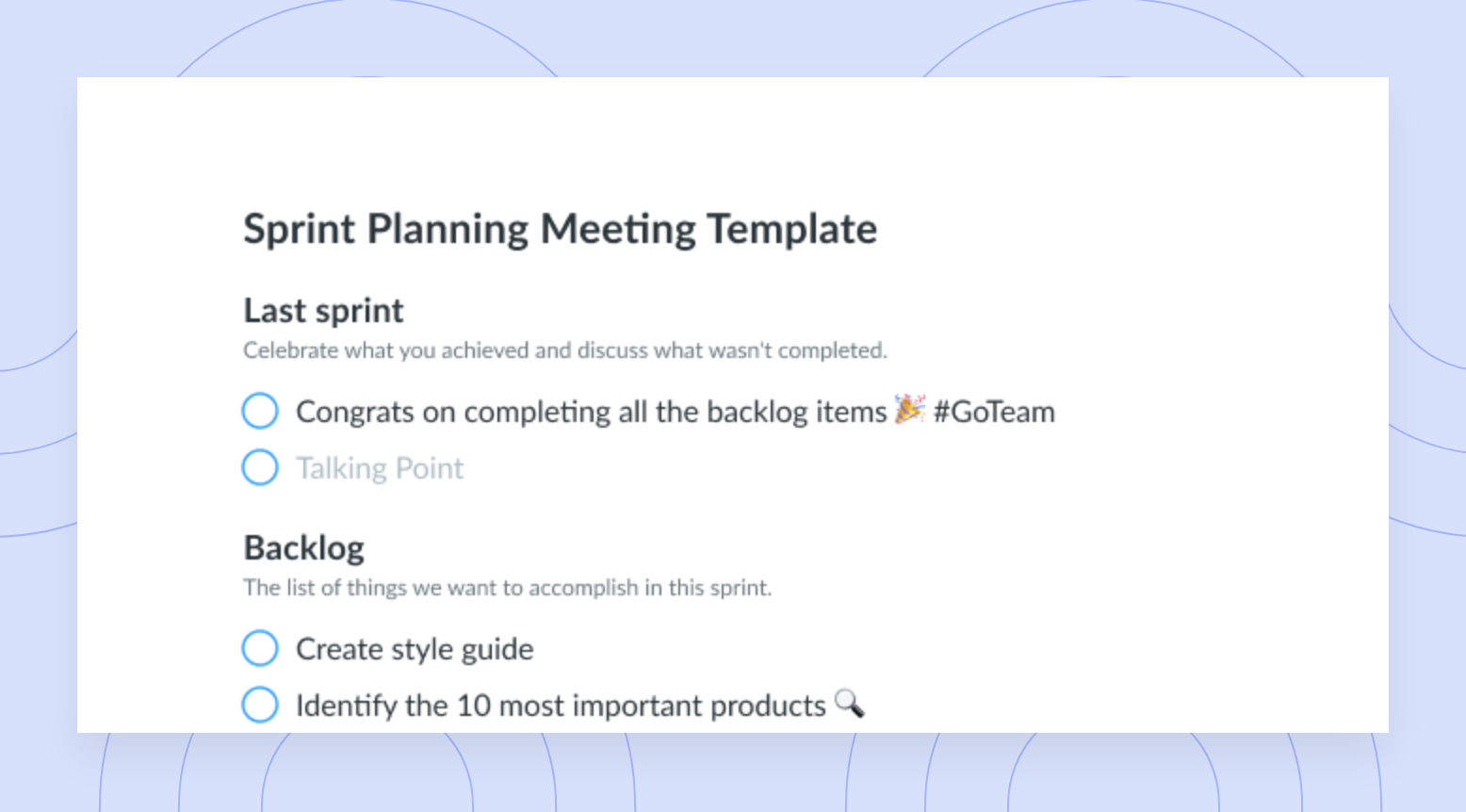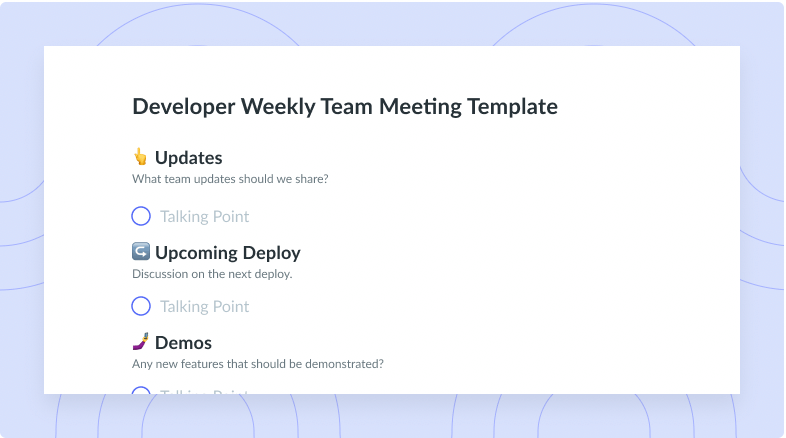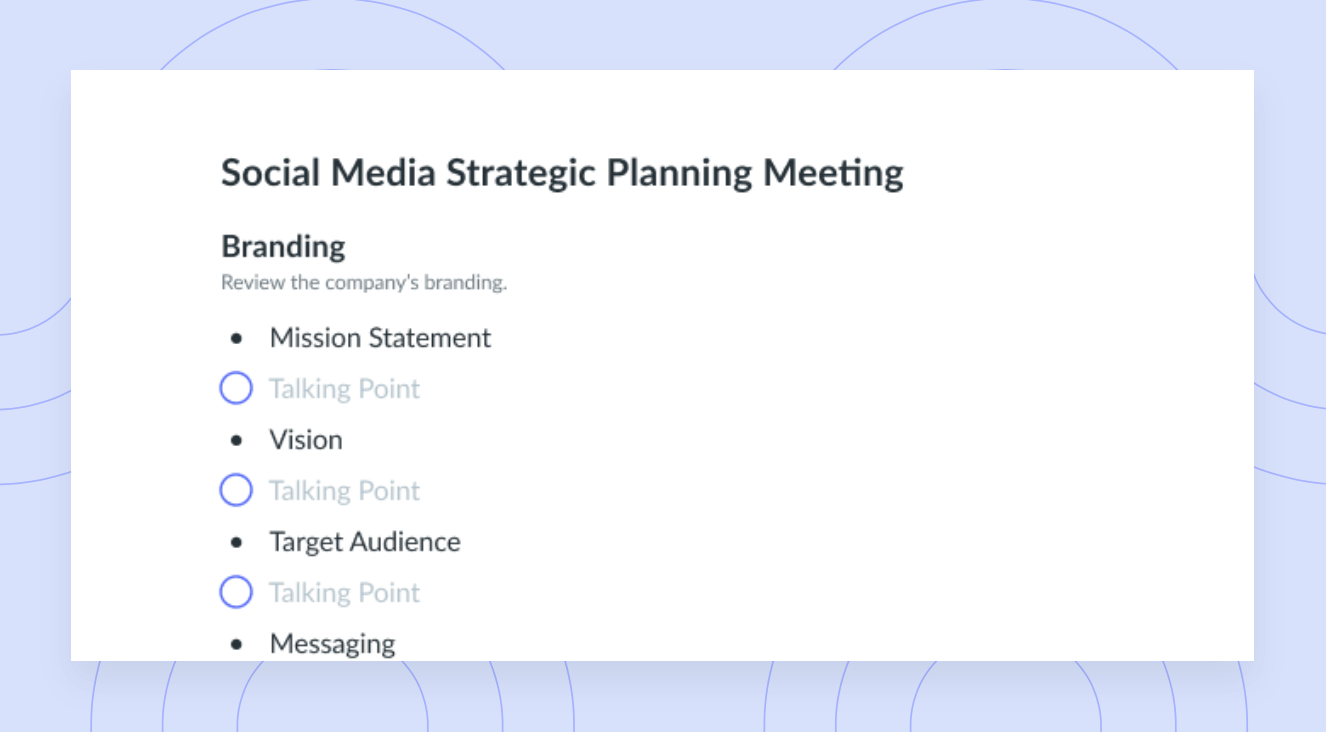Vision Meetings: The Ultimate Guide (+Tips)
A complete guide for vision meetings to clearly establish goals and determine next steps.
Vision meetings get everyone involved with a project – and we mean everyone – on the same page, so each person is working toward the same goals. You can hold them several times over the course of longer projects so that everyone is up to speed for the duration of the project. Learn all about these important meetings below.
- What is a vision meeting?
- What is the importance of a vision meeting?
- Stages of the meeting
- Seven tips for an optimal vision meeting
What is a vision meeting?
A vision meeting involves all stakeholders in a project. That means everyone on your team who’s working on the project will be present. If you’re working with outside vendors or clients outside your company, they will be a part of a vision meeting as well.
In most cases, your vision meeting will take place within the Scrum framework, making vision meetings the precedents to periods called sprints. During these sprints, you and your team will block out preset amounts of time to work on given tasks. The point of vision meetings is to identify these tasks and determine which tasks take priority over others. As you do so, try not to cram too many tasks into one sprint – most projects require several sprints.
Once your first sprint is over, it’ll be time to review your work at a – you guessed it – review meeting. Everyone involved in production then meets for a retrospective meeting during which steps for improving the next sprint are discussed. And then, the process repeats.
For some perspective on why vision meetings and the time-blocking involved in sprints go hand in hand, Charlie Gilkey, author of Start Finishing, offers some perspective.
“Time blocking – especially using what I call focus blocks – is my go-to practice,” Gilkey says. “It mitigates the efficiency drain from task-switching at the same time that it allows me to get real about what I can and can’t accomplish.”
What is the importance of a vision meeting?
Vision meetings are important for the start of pretty much any project. They get you, your team, and any other stakeholders aligned while creating an action plan. They give structure to projects that might seem overwhelming, and they do so time and again.
The key takeaway here is, vision meetings are important for initial goal development and continued movement through a project. That’s because the sprint following your first vision meeting is rarely your final sprint. Most projects involve several sprints, and a vision meeting should precede each one of them.
Think about it like this: Going into a sprint without a vision statement, time blocks, and tasks assigned to team members is like looking at a computer with sunglasses on. Sure, you might be able to see what’s in front of you, but it won’t be as clear as it could be.
Stages of the meeting
Now that you understand why vision meetings matter, you’re almost ready to prepare for your first one. After you take in the below meeting stages, you’ll be all the way there.
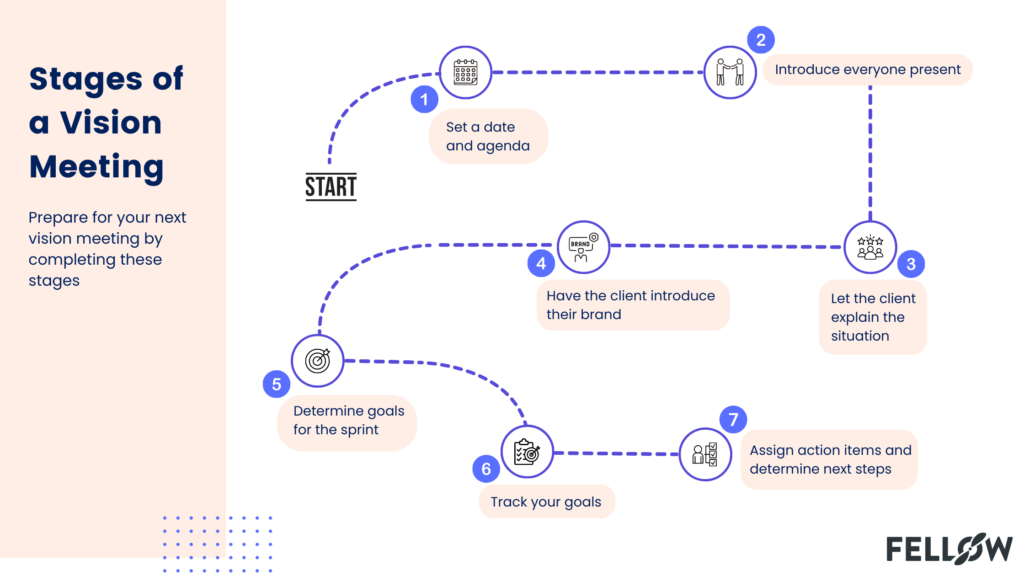
1 Set a date and agenda
As with all effective meetings, vision meetings should stick to a preset meeting agenda. Your vision meeting agenda should include the meeting’s overarching objectives, talking points, relevant documents, and decisions to be made. Action items should be added as they arise and assigned to attendees. Additionally, every part of the agenda should have a time limit so everything gets covered before the meeting adjourns.
You should also set a date, time, and location for your vision meeting well in advance. Once these details are set, get them out to all attendees ASAP. Don’t forget to include these details alongside your meeting agenda in your meeting recap.

Pro tip
Use a meeting management tool like Fellow to inform all the attendees what will be discussed throughout the meeting and easily send a recap.
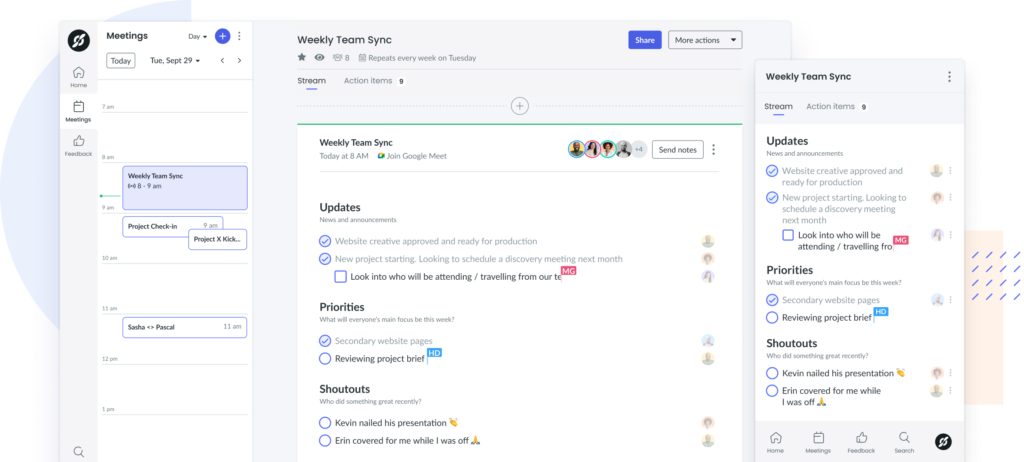
2 Introduce everyone present
Especially important for those outside your company who may be present, everyone in the room should introduce themselves and explain their role. This way, everyone knows all the people who are involved with your project and won’t be surprised to see certain names pop up at different stages. These introductions are also a great opportunity to showcase the diverse talents and skills your team brings to the table.
If your vision meeting is solely internal – this is okay occasionally if you’re on, say, sprint three out of five – you can skip this step. But it’s still a good idea to consider! Refreshing everyone in the room on who’s handling what and why the task has been delegated to them can improve communication and teamwork.
3 Let the client explain their situation
Now is the time when your team takes a step back and lets the client steer the car. Give your client the floor for as much time as they need (within reason) to outline their market, product or service ideas, competitors, and challenges.
At the intersection of these considerations lies the client’s vision, the very thing after which the meeting is named. Take notes as the client is speaking so you can follow up with questions or ideas once they’re done presenting.
4 Have the client introduce their brand
Branding is key to all of a company’s products or services, so your vision needs to incorporate it. Give your client space to elaborate on their vision, goals and thought process so you can come up with ideas on how to incorporate their ideas in the project. Encourage your client to use a brand deck to guide this portion of the meeting and keep things concise yet informative. Ask their permission to share this deck with your team so they can refer back to it during sprints.
If your client lacks meaningful brand outlines or is working with outdated branding, you may want to suggest making changes where needed. You can incorporate this work into your project if your team has experience in branding, or you can bring in brand consultants.
5 Determine goals for the sprint
With the client’s situation and branding on the table, everyone in the room can work toward a vision. For example, let’s say your software engineering team is meeting with a regionally-based car rental startup expanding into three new states. Let’s also say this client insists that its 24/7 rental model outdoes the name-brand rental companies. How, then, can you develop software that gets the client to successfully launch in these states while promoting its obvious advantages?
The answer could be incorporating the brand’s logo – a car under a transparent clock set to midnight – as location markers in the software’s map view. It could also be placing the slogan “ready when you are” on the screen at all points in the app. Perhaps these goals come from the client, or maybe they’re your own ideas. Either way, once they come up at the vision meeting, you can begin working on them and tracking them.
6 Track your goals
As mentioned earlier, a sprint comprises time blocks set aside for each team member to work on specific parts of the project. The thing is, no two team members work at the same pace. So, then, how can you track their progress toward your goals?
Time-tracking apps often help. So too do analytics showing whether the project milestones you’ve set are indeed pushing your team forward. For sprints that occur after a product hits the market – sprints focused on refinement rather than creation – tying your activities to increases in revenue may be helpful.
7 Assign action items and determine next steps
At the end of a vision meeting, everyone on your team should have action items for the sprint. Your team and your client should also know when your review and retrospective meetings will take place. Thereafter, you can set a date for your next vision meeting and repeat the entire process once again. Great products and services will result sooner than later.
Seven tips for an optimal vision meeting
To make the best of all the above vision meeting stages, consider the following tips as you structure your meeting:
- Review the meeting’s purpose beforehand
- Invite the right people in the room
- Schedule your meeting for the right time
- Relieve the pressure through games
- Stick to the agenda
- Catch technical errors before they arise
- Ask questions
1 Review the meeting’s purpose beforehand
Determine one general and one specific purpose for your vision meetings before holding them. A general reason could be that your team and the client need to get on the same page. A specific reason could be to ensure that your team has proper knowledge and resources to get started on the introductory phase of the project. This specific reason keeps your meeting focused on just what you can do now rather than the lifetime of the project so nobody gets overwhelmed.
2 Invite the right people in the room
Ideally, everyone involved in the project on your team and your client’s team should be at your vision meeting. Realistically, getting this many people in the same space at the same time can be tough. If this goal proves impossible, determine the key players from each side and make sure they’re in attendance.
3 Schedule your meeting for the right time
According to research from the U.K. software developer YouCanBookMe, the best date and time for meetings is Tuesday at 2:30 p.m. local time. Just think about this observation for a second, and it’ll make perfect sense. Who’s really entirely in the zone on Monday after the weekend? And who’s fully present on Friday as the weekend starts? By Tuesday afternoon, everyone will be settled in and ready to act on a well-defined and meaningful mission.
4 Relieve the pressure through team-building games
Your team might feel a lot of pressure going into vision meetings. What if their skills aren’t up to snuff for the job ahead? What if the client’s demands are unrealistic or not presented kindly? Relieve this pressure with team-building games. These activities build trust and rapport among all attendees, and colleagues on the same wavelength can better determine goals and plan sprints.
5 Stick to the agenda
We’ve all been in meetings where the agenda quickly goes from important guidance to all but nonexistent. It’s usually not a great feeling. Don’t let your clients experience this confusion and annoyance – instead, do all you can to stick to the agenda. Designating a timekeeper can help you achieve this goal, as can saving any agenda items that go overtime for discussion later rather than now.
6 Catch technical errors before they arise
A broken projector makes for an erratic vision meeting. It’s also something you can probably catch before your vision meeting. Test the technology you plan to use in the meeting beforehand, and consider doing so via a trial run in which your team can practice asking questions and devising goals. This way, you’re prepared for your vision meeting on every level and can sidestep any time-wasting delays.
7 Ask questions
Even the most well-prepared presentations are bound to leave you with some questions, and that’s natural. What might not feel as natural is finding the time and perhaps courage to ask for clarification. No, you shouldn’t interrupt someone who’s presenting, but you should jot down questions for later as the presentation proceeds. When the time comes, don’t hesitate to ask your question – chances are other people in the room need to hear the answer, too.
Time to build a vision!
The above guidelines should put you well on your way to vision meetings that clearly establish your clients’ goals and empowers your team to work toward them. Your first few meetings may seem imposing or nerve-wracking, but after a few sprints and reviews, the whole process will feel second nature. For especially smooth meeting planning and execution, Fellow’s meeting agenda and team meeting tools make all the difference.



![Sprint Planning Meeting Guide [+ Free Template]](https://fellow.app/wp-content/uploads/2020/12/Sprint-Planning-Team.jpg)





